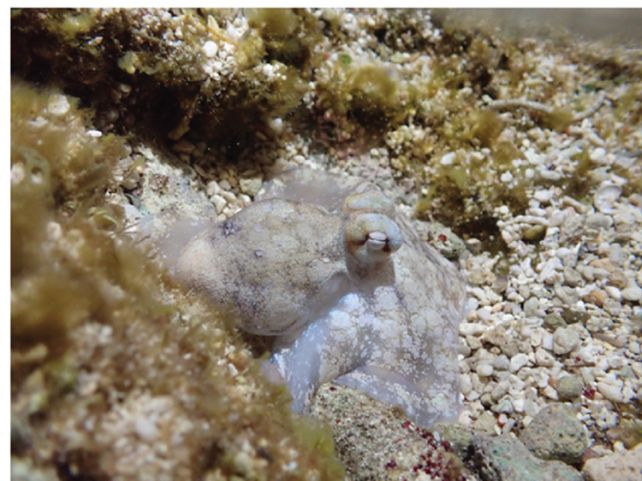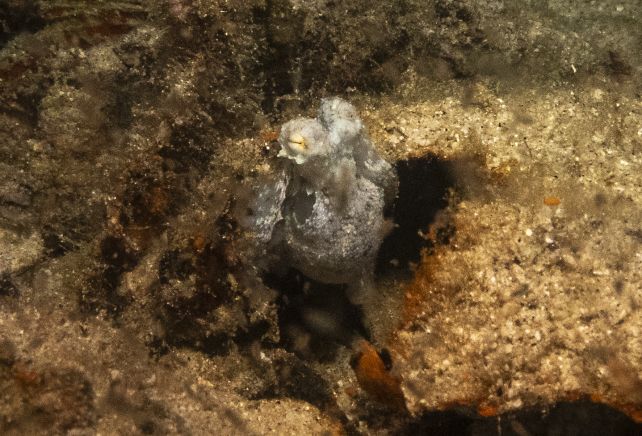A dive into the minds of sleeping octopuses has yielded further evidence that these enigmatic cephalopods experience REM sleep, or something very similar.
By simultaneously studying the coloration changes and neural activity of octopuses in the Land of Nod, a team of scientists led by the Okinawa Institute of Science and Technology (OIST) have confirmed the existence of alternating sleep states.
The more active of the two states, they discovered, bears a strong resemblance to activity seen when the octopus is awake.
Similar wake-like sleep activity occurs in other animals, such as mammals, during the REM phase of their slumber, when most dreams occur. It's not enough to conclusively declare that octopuses also undergo a REM sleep state, but it appears that, at the very least, they do something comparable – in spite of their brains being so very different from our own.
It's a fascinating discovery that could contain insights into the evolution and function of sleep.

"The fact that two-stage sleep has independently evolved in distantly related creatures, like octopuses, which have large but completely different brain structures from vertebrates, suggests that possessing an active, wake-like stage may be a general feature of complex cognition," says statistical physicist Leenoy Meshulam from the University of Washington in the US.
The neural architecture of octopuses (and other cephalopods) is wildly different from pretty much every other type of organism on the planet. But they seem to be wicked smart, with incredible problem-solving skills, and their brains do share a few striking similarities with ours.
Interestingly, it has recently emerged that something seems to be going on during their sleep. In 2019, an octopus named Heidi was recorded flickering and twitching while she dozed, raising some big questions.
For a long time, it was thought that only vertebrate animals underwent the REM phase of the sleep cycle – a deep sleep phase characterized by wake-like brain activity, twitching, and rapid eye movement under the eyelids, the activity that gives the phase its name.
But there were hints of something similar in the cephalopod family. In 2012, scientists found cuttlefish (Sepia officinalis) "display a quiescent state with rapid eye movements, changes in body coloration and twitching of the arms, that is possibly analogous to REM sleep."
This led scientists on an investigation. In 2021, a team led by neuroscientist Sylvia Medeiros of the Federal University of Rio Grande do Norte in Brazil observed color changes in sleeping octopuses of the species Octopus insularis, and found alternating sleep states; a quiescent one characterized by washed-out colorlessness, and an active, REM-esque one characterized by vivid flickering color changes, cycling through at 30- to 40- minute intervals.
Now, led by computational neuroethologists Aditi Pophale, Kazumichi Shimizu and Tomoyuki Mano of OIST, a team has taken that research a step further with a computational analysis of skin patterning and high-density electrophysiological recordings from the central brain from sleeping and awake octopuses of the species Octopus laqueus.
First, the researchers made sure they could tell when the octopuses were in la-la land, observing how the animals responded to a physical stimulus when sleeping and waking. They found that sleeping octopuses took longer to respond to the stimulus, whether in quiet sleep, or active, than when they were awake.
The next step was to record what happens during this period. The researchers found the nocturnal octopuses went very still and flat during the daytime, closed their eyes, and turned white. Roughly every hour this would change: for about a minute, the skin of the octopuses would flicker through a series of patterns, their eyes and limbs would move, and their breathing would quicken, before settling back down to the quiet state.
During each of these phases, their brains showed different kinds of activity. In quiet sleep, they had short bursts of neural activity, very similar to what are known as "sleep spindles" that show up as spikes in an electroencephalogram in non-REM sleep in vertebrates.
It's not known what the purpose of these activity bursts are in humans, but scientists believe they have something to do with cementing memories. The researchers traced the origin of this activity in the octopuses' quiet sleep to the memory and learning center of their brain, suggesting it could play a similar role.
During the cephalopods' active sleep, however, their brain activity was very similar to their brain activity while awake. Again, this is very similar to an REM sleep state in vertebrates.

Finally, the team closely examined the skin flickering during this wake-like sleep. While octopuses are awake, they can control the coloring of their skin using special pigment cells called chromatophores, for all sorts of reasons. They can camouflage themselves, respond to threats, and communicate with other octopuses.
During their wake-like sleep phase, the octopuses cycled through the different patterns they display for these purposes. It's certainly curious, but it's not clear why. It's possible that they're practicing their skin patterning, for example. It could also be that the activity is needed to keep the chromatophores in good working order.
But it's also possible, the researchers say, that the octopuses are reliving their waking experiences while they sleep – something very similar to dreaming. This would suggest that dreaming, whose purpose scientists have struggled to identify, is somehow beneficial to octopuses, too.
We can't draw that conclusion, not yet. But studying the octopuses more closely while they sleep and while they're awake could yield more clues.
"In this sense, while humans can verbally report what kind of dreams they had only once they wake, the octopuses' skin pattern acts as a visual readout of their brain activity during sleep," says experimental neuroscientist Sam Reiter of OIST.
"We currently don't know which of these explanations, if any, could be correct. We are very interested in investigating further."
The research has been published in Nature.
